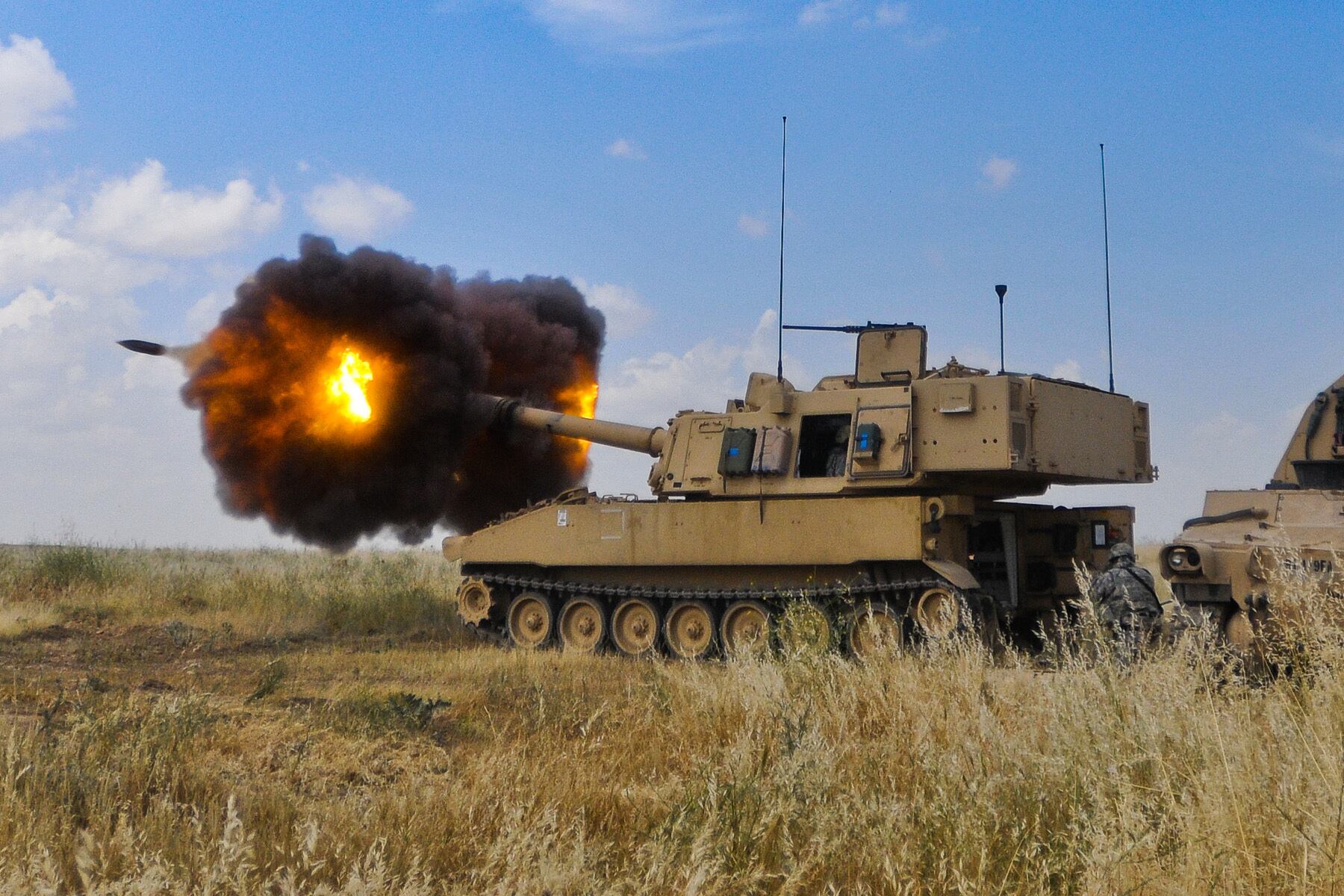WASHINGTON ― U.S. President Joe Biden has announced an additional $800 million in heavy weapons the country will speed to Ukrainian forces, which will include more than a dozen heavy-artillery howitzers, hundreds of armored vehicles and nearly a dozen helicopters, all from U.S. stockpiles.
Especially with the 18 towed 155mm howitzers and 40,000 artillery rounds, which the U.S. is providing for the first time, the Pentagon hopes to help even the odds against Russian forces, as the war enters a new phase, concentrated in eastern Ukraine. Moscow is now expected to bolster and resupply its forces in the Donbas region, where they can take advantage of shorter supply lines and open ground to employ tanks and more long-range fires, artillery and rocket capabilities, Pentagon officials said.
“It’s the first time that we’ve provided these [155mm] howitzers and the associated rounds, and that’s reflective of the kind of fighting that the Ukrainians are expecting to be faced with here in this more confined geographic area,” Pentagon spokesman John Kirby told reporters Wednesday. “They specifically asked for fire support, specifically for artillery.”
The package includes 10 more AN/TPQ-36 counter-artillery radars; two AN/MPQ-64 Sentinel air surveillance radars; 300 Switchblade drones; 500 Javelin anti-tank missiles; 200 M113 armored personnel carriers; and 100 armored Humvees.
Also included are 11 armed Mi-17 helicopters pledged to the now-defunct Afghan Air Force, which follow five Mi-17s diverted from Afghanistan in January.
One mystery on the list is an unspecified number and type of “unmanned coastal defense vessels” that the U.S. Navy will provide. Kirby described the drone heading to Ukraine only as “a surface vessel that can be used for a variety of coastal defense missions,” adding amid questions: “I assure you that they work.”
Also included is protective equipment against chemical, radiological and nuclear contaminants, 30 sets of body armor and helmets, more than 2,000 optics and laser rangefinders, C-4 and other demolition equipment, and M18A1 Claymore anti-personnel mines.
The Biden administration has committed $3.2 billion in military aid to Ukraine, $2.6 billion of which has come since Russia invaded in February.
The new aid will likely include training for Ukrainian forces by U.S. personnel, but not all the details were set. Those troops will likely need training on the howitzers, counter-artillery radar, Sentinel radars, Switchblades and perhaps the Claymores.
Over the weekend, a small handful of Ukrainian officers who had been doing professional military training in the U.S. since before the invasion returned home. In their final days stateside, they were trained on the Switchblade systems the U.S. has been sending into Ukraine.
Kirby said that instruction would take place on a “train the trainer” basis — so rather than sending entire units out of the country, it will likely be a small handful who will then return to Ukraine and train their own units.
“We’re still working through what those options are going to look like, what that train is going to look like, how many students are going to be involved in it, where’s it going to be, how long,” Kirby said.
There are thousands of U.S. troops deployed along the eastern border of NATO who could help out, including more than 5,000 in Poland and another group in Romania.
“It most likely is going to be multiple rotations,” Kirby said. “I don’t see this happening at just one place. And I think our goal would be to achieve this with our troops that are already there,” rather than deploying more troops for the mission.
Ahead of an hourlong call with Biden, President Volodymyr Zelenskyy posted a video with a detailed list of Ukraine’s equipment needs:
- 155mm artillery.
- 152mm artillery shells.
- Grad, Smerch, Tornado or H142 HIMARS multiple launch rocket systems.
- Infantry fighting vehicles or T-72 tanks.
- More S-300 air defense systems.
- Combat aircraft.
“Freedom must be armed better than tyranny,” Zelenskyy said. “Without additional weaponry, this war will become an endless bloodbath.”
Stacie Pettyjohn, director of the defense program at the Center for a New American Security, said Ukrainian forces could use their Bayraktar TB2 drones with the radars as well as howitzers and other ground-based artillery to “more effectively respond ― and hurt Russian forces at range without putting themselves in a vulnerable spot, and potentially eliminate some of the Russian systems they’re using to bombard the Ukrainians from further away.”
“They’re still battling to take control of eastern areas, so it’s probably a bit of a race to that,” Pettyjohn said. “Once [Russian forces] get into position and establish some defensive positions, it will be much harder to root them out.”
Wednesday’s announcement came hours after Deputy Defense Secretary Kathleen Hicks convened a classified meeting of defense industry CEOs at the Pentagon to gauge ― if the fight turns into a yearslong conflict ― their ability to produce weapons for Ukraine, the U.S. and other allies.
Lockheed Martin, Boeing, L3Harris Technologies, Raytheon Technologies, Northrop Grumman, BAE Systems, General Dynamics and HII were represented, according to Kirby.
“This [meeting] was really focused on the kind of systems and weapons that have been relevant in the Ukraine war,” Kirby said. “We wanted to make sure that we had a good, honest, candid discussion with these CEOs about the systems that they’re producing, the rate at which they’re produced, about the possibility for accelerating some of those production lines and expanding based on the heavy draw on our inventory.”
Joe Gould was the senior Pentagon reporter for Defense News, covering the intersection of national security policy, politics and the defense industry. He had previously served as Congress reporter.
Meghann Myers is the Pentagon bureau chief at Military Times. She covers operations, policy, personnel, leadership and other issues affecting service members.




